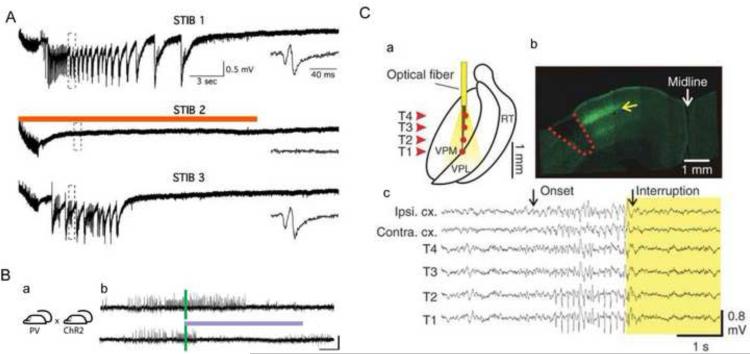Figure 3.
Optogenetic strategies for controlling epilepsy. A. First optogenetic epilepsy experiment. “Stimulation Train Induced Bursting (STIB) in CA3 is strongly attenuated by orange-light activation of transgene NpHR in organotypic hippocampal cultures. Recordings of 3 consecutive STIB stimulations, with orange-light illumination on second stimulation, in NpHR-transduced slices. Insets: Magnification of traces showing epileptiform bursts after STIB stimulation. Scale bars apply for all traces” Adapted with permission from PNAS (Tonnesen et al., 2009). B. Ipsilateral and contralateral control of seizures in PV-ChR2 mice. (a) Crossing PV-Cre and Cre-dependent ChR2 mouse lines generated mice expressing the excitatory opsin ChR2 in PV-expressing GABAergic cells (PV-ChR2 mice). (b) Example electrographic seizures in a PV-ChR2 mouse (top, no-light) truncated by blue (473 nm) light delivery (bottom, blue line) to the hippocampus. Adapted with permission from Nat Comm (Krook-Magnuson et al., 2013). C. Selective optical inhibition of thalamocortical neurons interrupts ongoing epileptic seizures in awake, freely behaving animals. (a) Diagram of chronic multisite optrode (CMO) implanted into somatosensory thalamus for behaving recordings and optical stimulations. Arrowheads indicate thalamic recording sites (T1–4). (b) Confocal image of coronal brain section taken through the cortical lesion (red dashed line) showing eNPHR-expressing thalamocortical fibers terminating mainly in layer 4 (yellow arrow) from a rat killed after recordings. (c) Representative example of simultaneously recorded cortical EEGs and thalamic LFPs before and during 594-nm light delivery in the thalamus ipsilateral to stroke. Arrows indicate seizure onset and its interruption by light delivery in thalamus. Adapted with permission from Nature Neuroscience (Paz et al., 2013).

